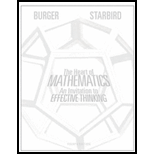
Concept explainers
Too high. Consider a tent function that got too high and sticks out over the top of the unit square. Let’s play the cobweb game and see which points stay within the unit square. Any point between 1/3 and 2/3 of the diagonal goes out immediately. Show that the point (1/6, 1/6), which lies on the diagonal above the interval [1/9, 2/9], leaves the square. How many steps are required? Likewise, show that the point (5/6, 5/6), which lies on the diagonal above the interval [7/9, 8/9], also leaves the square.
Want to see the full answer?
Check out a sample textbook solution
Chapter 7 Solutions
The Heart of Mathematics: An Invitation to Effective Thinking
Additional Math Textbook Solutions
A First Course in Probability (10th Edition)
Elementary Statistics: Picturing the World (7th Edition)
Graphical Approach To College Algebra
University Calculus: Early Transcendentals (4th Edition)
- 3. f(7) 3. Find the domain of each of the following functions. 1 1. f(x)=2-6x+8 2. f(x)=√√7-x 4. A manufacturer has a monthly fixed cost of $40,000 and a production cost of $8 for each unit produced. The product sells for $12 per unit.arrow_forward7. Evaluate the following limits and justify each step. (a) lim (3x²+2x+1) 1 x²+4x-12 (b) lim 1 2 x² - 2x t-√√3t+4 (c) lim t-0 4-t x²-6x+5 (d) lim (e) lim x 5 x-5 x→2 x²+2x+3 4u+1-3 (f) lim u➡2 u-2 1 (g) lim x-3 2 x 55 x - 7x4 +4 (h) lim xx 5x+2x-1 x+1 (i) lim x²-2x+5 - 7x8+4x7 +5xarrow_forward6. Given the following graph f(x). (-2,2) 2- -5 -3 -2 (-2,-1) -1 (0,1) -2- 1 (3,0) 2 3 4 5 (3,-1) א X Compute each of the following. (a) f(-2) (b) lim f(x) #129 (c) lim f(x) *→12+ (d) lim f(x) 811H (e) f(0) (f) lim f(x) 8011 (m) Is the function continuous at x = -2,0,3? Why or why not? (g) lim f(x) +0x (h) lim f(x) x 0 (i) f(3) (j) lim f(x) x-3- (k) lim f(x) x+3+ (1) lim f(x) #13arrow_forward
- (i) For a given constant a > 0, let an investor's preference be represented by the Gaussian utility function U(w)=1-e-aw² For what range of wealth level w will the investor be non-satiated and risk-averse? Explain your answer. (ii) Give an example of a utility function that exhibits DARA and verify it. (iii) Determine the class of utility functions with relative risk aversion coefficient R(w)= w², w> 0.arrow_forward3. Compute the profit corresponding to 12,000 units. 5. A rectangular box is to have a square base and a volume of 20 ft3. The material for the base costs $0.30 per ft2, the material for the sides cost $0.10 per ft2, and the material for the top costs $0.20 per ft2. Letting a denote the length of one side of the base, find a function in the variable x giving the cost of constructing the box. 6. Given the following graph f(x).arrow_forward8. On what intervals, each function continuous? (a) f(x) = 3x11 + 4x²+1 3x²+5x-1 (b) g(x) = x²-4 X, x < 1, QTs the function f(x) continuous at = 1? Use the definition of continuity to justifyarrow_forward
- review problem please help!arrow_forwardSara (a 23 year old college graduate) is starting her first career. She met with a financial planner and has determined that she wants $1,000,000 when she retires at the age of 63. She has found an annuity that pays 4.25%, compounded quarterly. What will she need to save each month, if Sara waits 20 years to start saving? N: P/Y: I%: C/Y: PMT: FV: End or Begin $4158.98 $4,115.26 $2645.83 $6,707.40arrow_forwardSara (a 23 year old college graduate) is starting her first career. She met with a financial planner and has determined that she wants $1,000,000 when she retires at the age of 63. She has found an annuity that pays 4.25%, compounded quarterly. What will she need to save each month, if a) Sara begins saving now? N: P/Y: I%: C/Y: PMT: FV: End or Begin $1,323.80 $1,376.59 $794.74 $1,000,000arrow_forward
- Algebra & Trigonometry with Analytic GeometryAlgebraISBN:9781133382119Author:SwokowskiPublisher:Cengage
 Algebra: Structure And Method, Book 1AlgebraISBN:9780395977224Author:Richard G. Brown, Mary P. Dolciani, Robert H. Sorgenfrey, William L. ColePublisher:McDougal Littell
Algebra: Structure And Method, Book 1AlgebraISBN:9780395977224Author:Richard G. Brown, Mary P. Dolciani, Robert H. Sorgenfrey, William L. ColePublisher:McDougal Littell Glencoe Algebra 1, Student Edition, 9780079039897...AlgebraISBN:9780079039897Author:CarterPublisher:McGraw Hill
Glencoe Algebra 1, Student Edition, 9780079039897...AlgebraISBN:9780079039897Author:CarterPublisher:McGraw Hill  College Algebra (MindTap Course List)AlgebraISBN:9781305652231Author:R. David Gustafson, Jeff HughesPublisher:Cengage Learning
College Algebra (MindTap Course List)AlgebraISBN:9781305652231Author:R. David Gustafson, Jeff HughesPublisher:Cengage Learning
 Elementary Geometry For College Students, 7eGeometryISBN:9781337614085Author:Alexander, Daniel C.; Koeberlein, Geralyn M.Publisher:Cengage,
Elementary Geometry For College Students, 7eGeometryISBN:9781337614085Author:Alexander, Daniel C.; Koeberlein, Geralyn M.Publisher:Cengage,





